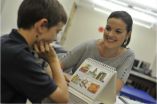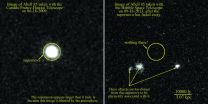Extra DNA creates cucumber with all female flowers
2015-06-04
(Press-News.org) ITHACA, N.Y. - Ask a plant researcher how the sex of a cucumber plant is determined and the person will tell you, "It's complicated." Depending on a complex mix of genetic and environmental factors, cucumbers can be seven different sexes. Some high-yield cucumber varieties produce only female flowers, and a new study identifies the gene duplication that causes this unusual trait.
The study, led by Zhangjun Fei of the Boyce Thompson Institute at Cornell University, and Sanwen Huang of the Chinese Academy of Agricultural Sciences, in Beijing, appeared recently in The Plant Cell.
Dutch breeders take advantage of "gyneoecious" varieties that produce only female flowers. When grown in nutrient-rich, soil-free greenhouses they produce a cucumber from each flower, greatly increasing the yield over "monoecious" varieties that produce both types of flowers. The female flowers must be fertilized by pollen from a male flower, but by controlling the sex ratio, growers can greatly increase their harvest.
"If you compare the greenhouse production in the Netherlands, which uses plants with female flowers, to China, where they use monoecious plants and normal agricultural practices, the production in the Netherlands is about 15 times greater than in China," said Fei. He explained that farmers in China do not plant gynoecious cucumbers because the nutrition in the soil is not sufficient for fruits to develop at each flower.
Though researchers have known since the 1960s that there was a genetic cause for all-female flower-bearing plants, the exact location and sequence of the responsible segment of DNA was previously unknown.
The researchers discovered the extra DNA by screening genome sequences from a core collection of 115 different cucumber lines. They looked for changes called structural variations--large regions of the genome that are missing, added, reversed or duplicated. They generated a map of the 26,778 different structural variations that they found, some of which are associated with cucumber domestication. The analyses show that collectively, these structural variations affect more than 1,600 genes in the cucumber genome.
"It turns out that we found this one specific structural variation that is a duplication of about 30,000 bases. The duplication was highly correlated with gynoecy," said Fei. "For female flowered-plants, there's a lot of potential for agricultural production."
The study builds off of previous work by Fei, Huang and colleagues, who collaborated in sequencing the initial cucumber genome and later published a paper that identified single base differences called SNPs, between multiple cucumber lines.
INFORMATION:
Cornell University has television, ISDN and dedicated Skype/Google+ Hangout studios available for media interviews.
ELSE PRESS RELEASES FROM THIS DATE:
2015-06-04
Chicago - June 4, 2015 - It may be better for patients to resume taking their blood pressure medication sooner after surgery than previously thought. A new study published in the Online First edition of Anesthesiology, the official medical journal of the American Society of Anesthesiologists® (ASA®), found resuming angiotensin receptor blockers (ARBs), common medications used to treat high blood pressure, within two days after surgery decreased death rates in the first month following surgery.
"Sometimes doctors briefly stop ARB medications around the time of ...
2015-06-04
A 333-million year old broken bone is causing fossil scientists to reconsider the evolution of land-dwelling vertebrate animals, says a team of palaeontologists, including QUT evolutionary biologist Dr Matthew Phillips, and colleagues at Monash University and Queensland Museum.
Analysis of a fractured and partially healed radius (front-leg bone) from Ossinodus pueri, a large, primitive, four-legged (tetrapod), salamander-like animal, found in Queensland, pushes back the date for the origin of demonstrably terrestrial vertebrates by two million years, said Dr Phillips, ...
2015-06-04
Research by Catherine Klein, an undergraduate in Bristol's School of Earth Sciences, shows that fossils from the previously unstudied Woodleaze Quarry belong to a new species of the 'Gloucester lizard' Clevosaurus (named in 1939 after Clevum, the Latin name for Gloucester).
In the Late Triassic, the hills of the South West of the UK formed an archipelago that was inhabited by small dinosaurs and relatives of the Tuatara, a living fossil from New Zealand. The limestone quarries of the region have many caves or fissures containing sediments filled with the bones of abundant ...
2015-06-04
New research has revealed that parasitic 'vampire' plants that attach onto and derive nutrients from another living plant may benefit the abundance and diversity of surrounding vegetation and animal life.
By altering the densities of the hemiparasite (a parasitic plant that also photosynthesises) Rhinanthus minor, in the Castle Hill National Nature Reserve in Sussex, ecologists from the Universities of York, Sussex and Lincoln were able to assess the impacts of the 'vampire' plants on the biodiversity of a species-rich semi-natural grassland. The scientists compared ...
2015-06-04
NORTH GRAFTON, Mass. (June 4, 2015)--Birds, like people, can suffer from conditions where a blood transfusion is a necessary life-saving measure. But in many instances, unless an avian donor is readily available, accessing blood is impossible because of the challenges associated with storing the species' red blood cells.
New research published in the American Journal of Veterinary Research has found that a substance called dimethyl sulfoxide (DMSO) shows promise as a potential cryopreservant for freezing avian blood.
"Birds are susceptible to various causes of blood ...
2015-06-04
In many animal species, the chromosomes differ between the sexes. The male has a Y chromosome. In some animals, however, for example birds, it is the other way round. In birds, the females have their own sex chromosome, the W chromosome. For the first, researchers in Uppsala have mapped the genetic structure and evolution of the W chromosome.
Every individual of a species has the same sorts of chromosomes, with one exception. In many species, the way the sexes differ is that males have their own sex chromosome, the Y chromosome. This contains genes which result in the ...
2015-06-04
ARLINGTON, Texas -- Toys, appliances, and even a sofa and coffee table can impact the way or when a baby first crawls, walks or achieves other growth milestones, but a new UT Arlington study finds that many parents are unaware of the significant role household items play in their infant's motor skill development.
Priscila Caçola, an assistant professor of kinesiology in the UT Arlington College of Nursing and Health Innovation, co-developed a simple questionnaire for caregivers of infants aged 3 to 18 months that she says can aid in the evaluation of toys and other ...
2015-06-04
From AGU's blogs: Flooding, erosion risks rise as Gulf of Mexico waves loom larger
Waves in the northern Gulf of Mexico are higher than they were 30 years ago, contributing to a greater risk of coastal erosion and flooding in Florida, Alabama, Mississippi and Louisiana, according to a new study in Geophysical Research Letters.
From Eos.org: Building Sandbars in the Grand Canyon
Annual controlled floods from one of America's largest dams are rebuilding the sandbars of the iconic Colorado River, according to a new article by U.S. Geological Survey scientists in Eos. ...
2015-06-04
Sharp images obtained by the Hubble Space Telescope confirm that three supernovae discovered several years ago exploded in the dark emptiness of intergalactic space, having been flung from their home galaxies millions or billions of years earlier.
Most supernovae are found inside galaxies containing hundreds of billions of stars, one of which might explode per century per galaxy.
These lonely supernovae, however, were found between galaxies in three large clusters of several thousand galaxies each. The stars' nearest neighbors were probably 300 light years away, nearly ...
2015-06-04
AURORA, Colo. June 3 -- As America's obesity epidemic continues to grow, a new study from the University of Colorado Anschutz Medical Campus shows that a low-cost, non-profit weight loss program offers the kind of long-term results that often elude dieters.
'We know that people lose weight and then gain it back,' said study author Nia S. Mitchell, M.D., MPH, a researcher with the Division of General Internal Medicine at the Anschutz Health and Wellness Center at CU Anschutz. 'In this case, we found that people who renewed their annual membership in the program lost a ...
LAST 30 PRESS RELEASES:
[Press-News.org] Extra DNA creates cucumber with all female flowers

